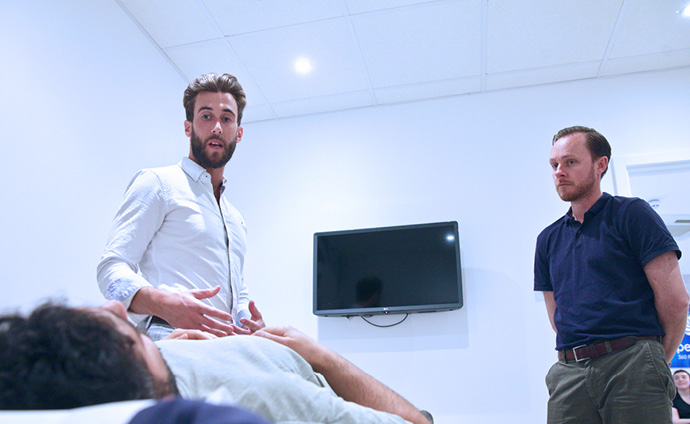Some would say it’s a unique business model… while many businesses measure success by how many times a customer comes back to use their services or products, at Spectrum we actually measure success by how many clients we discharge at full health. Our ultimate performance metric is essentially to put ourselves out of a job!
But what does a ‘standard’ experience at Spectrum look like and how does it differ from your ‘classic’ physio experience of regular appointments that rely solely on hands-on treatment and exercise?
In reality, there is no standard experience, because we completely personalise everything to suit the needs of our individual patients. We take time to get to know you and understand all relevant aspects of your lifestyle and why you’ve come to see us in the first place. We also take into account your treatment goals, the mental and social factors that could have contributed to your injury or condition and your day-to-day routines such as habits and posture.
We also have a team of people dedicated to helping you — so while you will book in to see a lead physio, across a single appointment you will likely see multiple practitioners, such as sports therapists or a secondary physio, to give you a fuller treatment experience. Essentially, the key difference between a sports therapist and a physio is that the physio will administer all the hands-on work and prescribe a programme, whereas a sports therapist will run the exercises programme and monitor the technology used during treatment. And with a standard appointment fee but no time limits on appointments, you can be sure you won’t be rushed in and out before your treatment is complete.

It can be a little tricky to get your head around at first, so we find the easiest way to explain it is using an example — let’s pretend we have a patient called Sanjay who is suffering from pain in his achilles.
When Sanjay first comes in complaining of an achilles problem, a sports therapist will normally start the initial assessment and ask for his medical history. Next your physio will come in to do the objective assessment, which is the physical handling component, and it’s common with achilles pain to begin by assessing calf strength.
There are two layers to the calf muscle, so we would first check to see whether one of those areas could be causing the problem. If we found they were, then we’d provide Sanjay with an entry level exercise programme. On top of this, we’d apply the GameReady Ice/Compression unit to his ankle to reduce any swelling and then use Shockwave treatment on the achilles itself, to help the tendon recover faster.
From here, Sanjay might receive some hands-on release work around the achilles, the calf, or anywhere up the leg based on where the tightness that could be contributing to his achilles overload is occurring. It could even be as far up as the abs or the glutes, which we would only know after a thorough assessment. If this was the case, we’d then follow with some release work including dry needling, if it was appropriate. An assistant therapist who helps manage the flow of the clinic may help take Sanjay on and off ice, or remove needles and just generally check on him to see how he is getting on in between therapies.

A sport therapist would normally take over again at this point to run Sanjay through his set exercise programme in our in-clinic gym, and check his calf strength as he goes. They would also be there to teach Sanjay any new exercises required as he progresses, to allow him to self-manage his treatment ongoing. They might also use the TENS machine to stimulate any of Sanjay’s muscles that are not switching on properly. The TENS can be used stand alone or while he is doing exercises in the gym.
Sanjay would also be given access to an app called Track Active, which is the platform we use to record a patient’s list of exercises (even rep numbers!) so they can recall them easily after the appointment. We’ve recorded video demos and photos of all our exercises so patients don’t have to remember anything off the top of their head. We’ve found it’s a really useful tool with patients to help them keep consistency and correct form, even when doing exercises at home.
The combination of all of these treatments and experts will mean Sanjay has a high chance of walking out of the clinic fully discharged sooner rather than later — a win for him and for us.
So, there you have it! That is a snapshot of what the Spectrum experience looks like and why we focus on putting ourselves out of a job…
Want to learn more about our unique approach? Visit our website today!



